Golf iron tips for beginners: how to instantly improve your iron play
It seems that in golf, driving and putting get all of the attention. Iron play is one of the most overlooked of a beginner’s golf game. However, a good iron shot is also what separates the good players from the great players. A strong iron shot can get you to the green faster and closer to the hole. Use these golf iron tips for beginners to begin shaving points off your score.
Golf tips for beginners: Iron play fundamentals
Stance basics for iron play

When setting up your golf swing, it’s important to get into a good stance that allows you to relax and hit the ball comfortably. Start out standing with your feet about shoulder length apart. Also keep your knees slightly bent and the rest of your body loose.
Beginner golfers should position the golf ball in front of them and even between their front foot and back foot. Then have the length of the golf club dictate how far away to stand from the golf ball. The goal is to stand a distance that is comfortable for you.
Common advice for hitting with long irons is to place the golf ball closer to the front leg. However, we recommend that beginners position themselves similarly for all iron shots. The only difference for short vs long clubs should the distance from the ball.
Beginners need a consistent golf swing setup to develop their golf game. Approaching each swing the same will give newer players the repetition they need to hit crisp iron shots. As players improve, they can begin to adjust their stance for different situations.
Grip basics for iron play
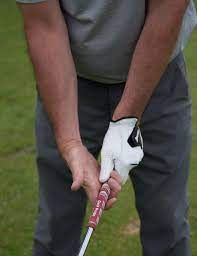
A solid grip is important for any player that wants to hit irons well. For right handed golfers, you want to position the club’s grip on the second knuckle of the index finger on your left hand.
The club should come to a rest just below the place on your hand where your palms meet your little finger. The little divot between the base of your thumb and palm on your left hand should point up towards your head.
Make sure that you set your grip first before you squeeze or turn the club. This will help ensure that the club head is rotated properly towards the golf ball. Doing this will better position you to hit your iron shots square on.
Golf swing basics for iron play
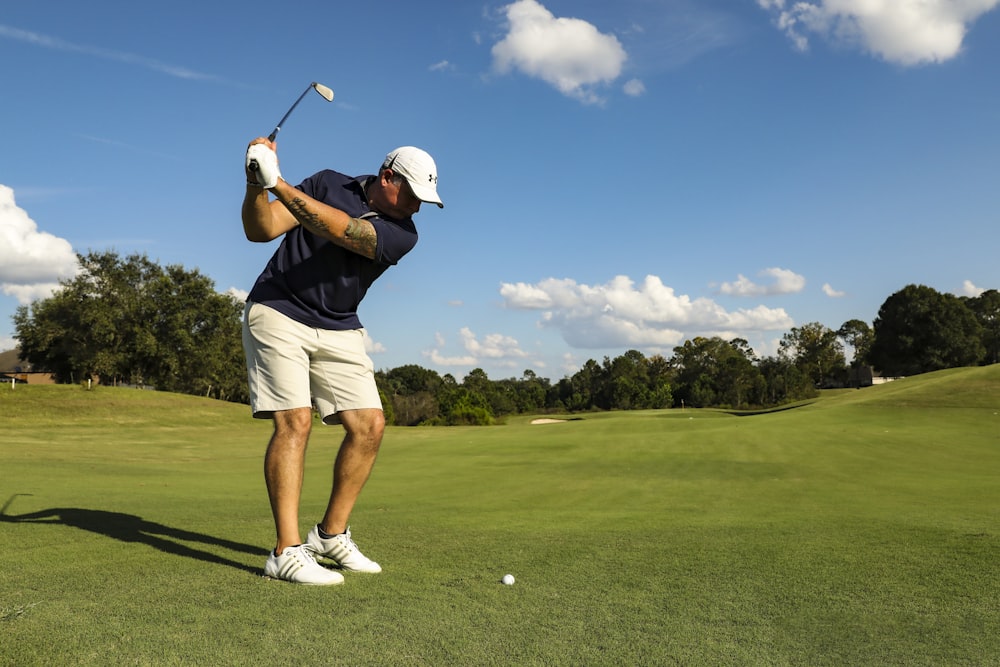
In general, you will use a similar golf swing for irons that your would use for your drivers or woods. A good golf swing will have the following fundamentals:
- A club head that hits the ball square on
- Good hip rotation and shoulder turn
- A club shaft that stays on-plane the entire swing
- Solid contact with a strong follow through
Beginners should stick to a similar golf swing for all of their hits. Repetition with ball striking is the quickest way to develop a consistent shot with good swing speed.
Hitting through the golf ball
The key to hitting crisp iron shots is hitting through the golf ball. Of all the golf iron tips for beginners, this is the most important. Doing this properly will allow your to hit your irons pure with good swing speed.
Many beginners have a tendency to hit irons down rather than through the ball. Hitting down often causes the club head to take out a chunk of grass before hitting the ball. This can interfere with swing path of the golf club and slow the swing speed down, resulting in poor contact and reduced ball flight distance.
How to tell if you’re hitting down or through the ball
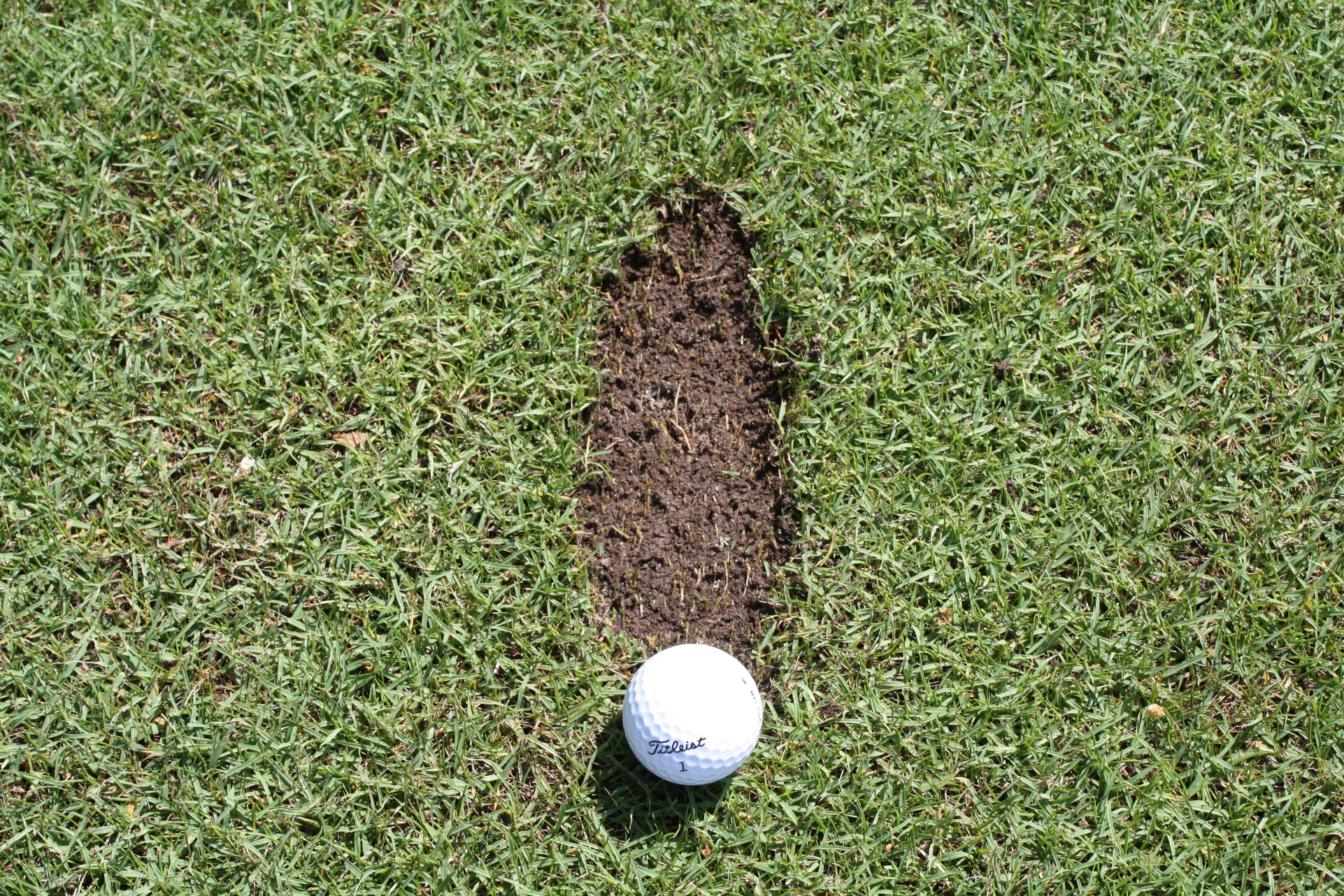
To see if you’re hitting down, look at the grass after you hit your shot. If you see divots in the grass before the spot where the ball was, you’re hitting down.
Ideally, you should see divots in the grass after the ball spot. This means that you hit your irons pure. It’s okay to take a little grass with your golf club after you’ve already hit the ball.
Proper form to hit through the ball
Proper swing form starts with good hip rotation. Good rotation will keep you from rocking back on your swing. The easiest way to rotate your hips is to imagine your back hip replacing your front hip when taking your backswing.
If your rotate your hips rather than rocking back, you will naturally hit the ball with most of your weight on your lead foot. Your club shaft should also be leaning forward slightly. In this position, the club will still be traveling down after hitting the ball, hitting the grass after the ball.
A great drill for hitting through the ball
One easy way to practice hitting through the ball is to line up several balls in a row. These balls should be set up so that they can be hit in quick succession. Set it up so that you can hit one, then move up one step and hit the next one, and so on. If needed, you can use alignment poles when placing your balls.
Set you golf balls up in a grassy area so that you can examine the grass after each shot. Look to see where the divot is after hitting. If the divot is before the ball, you’re still hitting down and need to adjust. If the divot is after the ball, you’re hitting through it.
Iron shots vs driver shots
Good iron shots and good driver shots are similar, but there are some key differences that you should know. The most important difference is when you make contact with the golf ball:
- To hit good driver shots, make contact immediately after the low point of your golf swing
- To hit crisp iron shots, make contact slightly before the low point of your swing
When you make contact with the ball when using your driver, your golf club should be on an upward path from its lowest point. This is why people elevate their golf balls on a tee when using a driver.
When you hit irons, as previously discussed, you want to hit through the ball. The low point occurs after you hit the ball, and may leave a divot in the grass after the ball.
A good iron shot has the following setup:
- Ball centered between the front and back foot
- Lean slightly forward
- Have a slight forward shaft lean
A good driver shot has the following setup:
- Ball should be towards the front foot
- Shaft lean should be neutral
These small differences can help you master both the driver shot and the irons shot.
Golf iron tips: Short irons vs long irons
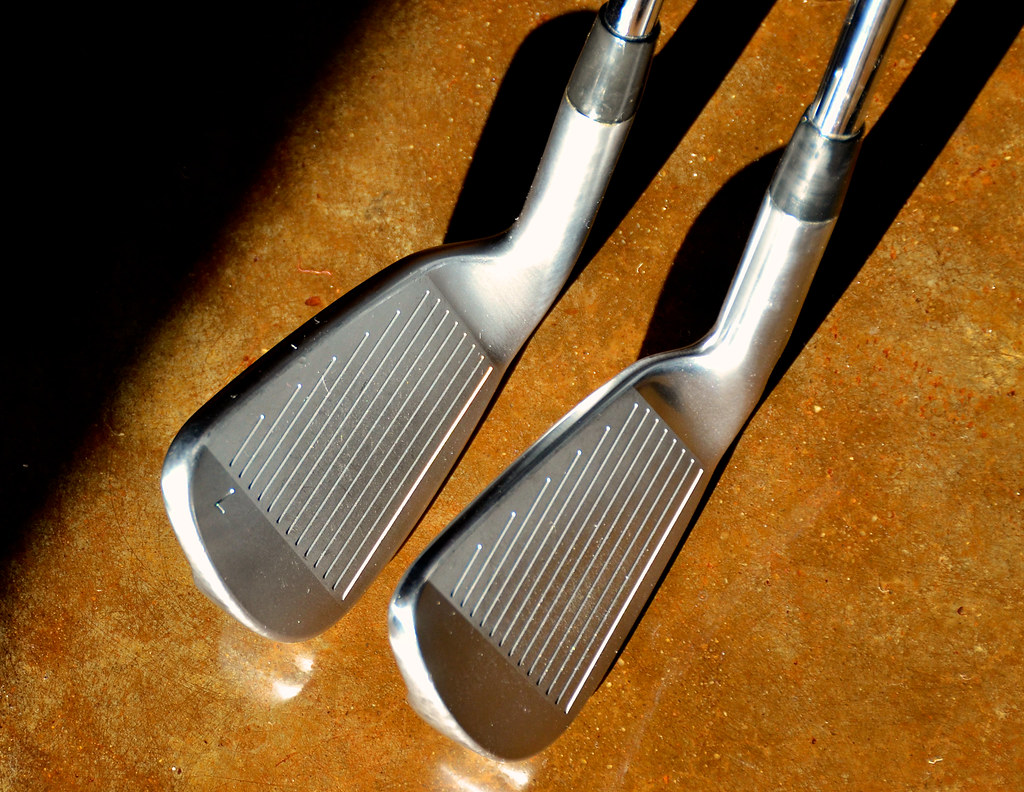
We recommend that beginners start out hitting all of their irons the same way. This helps drill repetition so that you can get a good feel for hitting irons.
Eventually you should change up your golf swing depending if you’re hitting long irons or short irons.
Different irons are designed for different situations, and are numbered accordingly:
- Short irons (irons 8 and 9) have high loft and are good for lofting your ball when you’re close to the green.
- Medium irons (irons 5, 6, and 7) have less loft and are designed for medium distance
- Long irons (2, 3, and 4) have even less loft and are designed for longer distances.
Using a short iron golf club
When hitting a short iron golf club, you should be hitting at a fairly steep angle. A shorter iron golf stance will:
- Have the feet shoulder width apart with a relaxed stance
- Have the golf ball in the middle of the stance between both feet
- Your body should be straight up and down
- Golf ball should line up slightly forward of your nose
- The club shaft should have a small forward lean to it
Using a long iron golf club
When hitting with a long iron golf club, the angle should be less steep than a short club. A longer iron golf stance will:
- Have the feet shoulder width apart with a relaxed stance
- Have the golf ball slightly forward of the middle between both feet
- The club shaft should be fairly straight up and down
- The golf ball should line up with your front ear
- The body should be straight up and down
The best drills progression for iron play
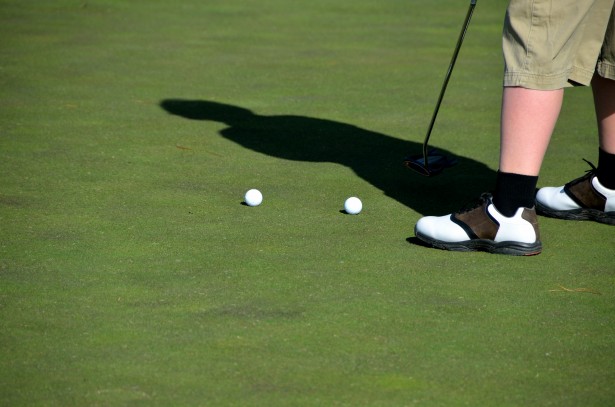
While we could talk all day about the finer points of iron play, the reality is that improving requires lots of practice and drills. Most importantly, players need a good progression of drills that instills the basics before moving on more advanced parts of the swing.
A good progression should teach the following concepts:
- Controlling your low point
- A basic swing path
- Controlling your ball curve
- Adding speed to your golf swing
Low point control drill
As we’ve emphasized several times, controlling your low point is the biggest fundamental needed to hit crisp iron shots. When you hit irons, the low point in the swing always needs to come after hitting the ball and not before.
While we’ve already discussed one great drill for doing this, we have one more to try. To do this drill:
- Mark a line a couple of feet long
- Grab a whiffle ball and put it on the line
- Practice hitting the whiffle ball several times.
- See how many times your contact point is on the front part of the line
Eventually you should get to the point where almost all of you shots have their low point past the line. Doing this drill enough will eventually put this habit on “autopilot”, making your life much easier on the golf course.
When you do this drill, remember that your should be leaning towards your front foot slightly, which can help you move your low point forward.
1 and 2 drill
The 1 and 2 drill involves using short swings to simplify and teach the swing path. The 2 swing is a swing that’s about half speed from your normal swing. The 1 swing is even shorter and has an even more limited path.
The 1 swing should:
- Be about 1/4 of your normal speed
- The backswing should come to about waist level
- Follow-through should not go past waist level
- Don’t hinge your wrists at all
- This swing is mainly about rotating your body
The 2 swing should:
- Be about 1/2 of your normal speed
- The backswing should come back to your head but not past
- Follow-through should also go to you head but not past
- Hinge your wrists for this one
Practice several 1 swings (up to 10), then several 2 swings (also up to 10). You can practice these swings with or without the ball. After taking several practice swings, then take a full golf swing. These drills should help the swing path to feel more natural for you.
Stock shot drill
The stock shot drill can teach you how fade and draw properly on a hit. A fade is when you hit the ball forward curving away from you. A draw is when you hit the ball forward curving towards you.
To do this drill, go to a driving range and set up an alignment stick a few yard in front of you, straight down the target line.
Next, you want to practice hitting the ball to the left or to the right of your target. That’s the entire drill, which will help you develop your stock shot.
Speed golf training drill
Once you have a consistent shot, you’ll want to start adding speed to your swing. Golf is a game a speed. A faster golf swing will hit the ball further, which will cut down on the number of shots that you will need to take.
The best speed golf drill is to try swinging your golf club like a baseball bat. For this drill, you want to do the following:
- Grip the club head and hold it out horizontally in front of you so that the club grip is sticking away from you
- Swing the shaft around you while keeping it horizontal. The swing should be similar to swinging a baseball bat. Listen and try to create the loudest swoosh sound you can.
- Turn the club around so that you’re holding the grip with the head away from you. Make another fast swing, again aiming for the loudest swoosh sound your can make.
- Return to a normal swing and now do the normal swing as fast as you can
- Put a ball down and try to hit the ball with a fast swing
You’ll notice that you get the loudest swoosh when you take a swing with relaxed arms, using your hip and body rotation to swing the club shaft.
Common myths that are ruining your iron shot
It seems that sometimes there is just as much bad information floating around the golf course as there is good information. There are a couple of popular misconceptions about iron play that are flat out untrue. Don’t let these mistruths hold back your golf game.
Myth #1: Keep a straight lead arm
Many people on the course seem to think that you should hit your irons with a straight lead arm. Anyone who has actually tired this should quickly realize that this does not help.
In fact, it can actually hinder your game. Keeping a straight lead arm can add tension to your whole body and force it into an awkward position during your swing.
It’s much better to keep both of your arms loose. Relaxing your body is one of the most important things in golf. Keep the slight bend to your arms that you naturally have when they’re resting against your body.
Myth #2: Put your head down
Keeping your head down is a popular idea that unfortunately is completely wrong for good swing mechanics. Keeping your head down will add tension to your shoulders, which can then interfere with your swing rotation. People who follow the advice tend to have very rigid swings.
Instead, allow your head and chin to rise a bit when you take your swing. This will allow for a more natural motion that doesn’t constrict your body.
Myth #3: Flexing your trail knee
This is a bad piece of advice. The purpose of flexing the knee is to restrict hip movement. There is no real good reason to do this.
Restricting hip movement will lead to an awkward swing path. Not only that, but it can also hurt your back. Not good!
Instead, simply allow your leg to bend slightly when you go through the movement. There is no reason to lock your leg as it is not a part of the normal swing path, so this one should be easy to avoid.
Conclusion
Iron play is one of the toughest parts of golf to master, and what separates the good players from the great players. Beginners should focus on their iron shot fundamentals using the drills discussed in this article. Good iron play will get your to the green faster and start shaving points off your game.
FAQ
To hit an iron correctly, first line up your shot with your ball midway between your feet and a relaxed stance. Then make sure that the low point of your swing comes after you hit the ball.
Three good golf tips are: Rotate your hips well, hit down and through the ball, and keep a relaxed stance with your ball midway between your feet.
Beginners can stick with a 7 or 8 iron for shorter distances (under 120 yards), and a 4 or 5 iron for longer distances.
There are several drills outlined in this article that you can practice, but the most important thing is to make sure your swing low point comes after you hit the ball.

